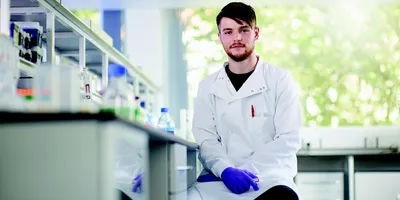Researchers at Flinders University have discovered a new low-cost material that can be made into lenses for thermal imaging—pointing to new advanced manufacturing applications for this powerful technology.
Thermal and infrared imaging are used in many industries including defense, security and surveillance, medicine, electrical engineering, space exploration, and autonomous vehicle operation—but the materials required are expensive and becoming more difficult to find.
Lower cost alternatives are needed so a multi-disciplinary team in chemistry and physics at Flinders University have developed a solution in an entirely new polymer material made from sulfur and cyclopentadiene. They say the high-performance polymers have the unique ability to transmit infrared light.
"The material combines high performance, low cost, and efficient manufacturing,” says PhD candidate Sam Tonkin, first author in a new article in the international Advanced Optical Materials journal.
“It has the potential to expand the use of thermal imaging to new industries, which were previously limited by the high cost of germanium or chalcogenide lenses. This is a rapidly developing field, which will see exciting advances in the next few years," he says.
Sulfur is produced in many millions of tonnes in petroleum refining. Billions of tonnes are available in geological deposits. It is plentiful and cheap.
Cyclopentadiene is also derived from low-cost materials produced in petroleum refining.
The lenses used for thermal imaging are currently made from germanium or chalcogenide glasses. Germanium is an element in short supply and it is very expensive. Some germanium lenses can cost thousands of dollars.
Chalcogenide glasses also have shortcomings. For instance, they are often made of toxic elements such as arsenic or selenium.
Co-author Dr. Le Nhan Pham, a Flinders University researcher in computational and physical chemistry, says reacting sulfur and cyclopentadiene together provides a black plastic with high transparency to infrared light.
“This is the light that is detected by thermal imaging cameras.
“This novel material was designed to have a wide array of potential applications from space engineering to military operation, and to civil and aerospace industries.” he says.
The polymer can be molded into a variety of lenses, which can be used, for example, to magnify the image in a thermal camera. Because the polymer is black, it can also be used to conceal and protect thermal imaging equipment. The polymer can therefore be used as camouflage to hide a camera used for surveillance.
The infrared light passes through the polymer, so one can see through it using an infrared camera. This property is useful for defense operations and wildlife surveillance.
The polymer also has many other features:
- The material has the highest long-wave infrared light transparency ever reported for a plastic.
- The raw materials are low cost: for a 1 g lens the building blocks cost less than 1 cent.
- The material allows rapid molding into various shapes such as lenses. This is a more rapid process than current lens production that relies on slow milling methods.
The study also reported some key scientific advances, including:
A new reactor was designed to enable the key reaction. A key challenge was to be able to use the building blocks in gaseous form. The use of gaseous monomers was previous thought not to be possible by other researchers in the area.
The study also includes quantum mechanical calculations to understand how and why the material is transparent to infrared light used in thermal imaging. These insights will also be useful in the future to design new lenses with further improved properties.
- This press release was provided by Flinders University










